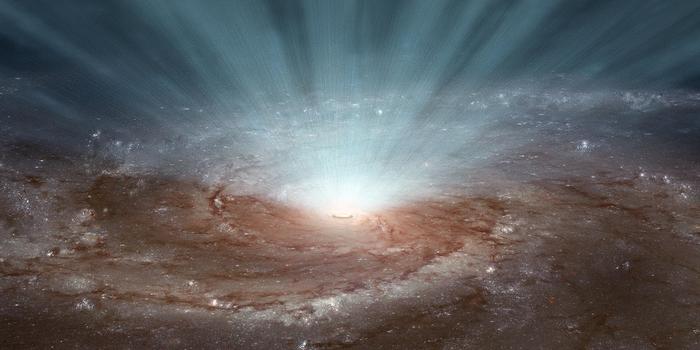
The cosmos incessantly bombards our planet with a fascinating array of high-energy particles and radiation spanning the entire electromagnetic spectrum, from radio waves to gamma rays. Among these cosmic phenomena, an enigmatic and particularly intriguing class stands out: ultra-high-energy cosmic rays. These particles, often atomic nuclei accelerated to breathtaking energies, have long puzzled astrophysicists due to their elusive origins and extraordinary power. Despite decades of observation, the precise mechanisms propelling these phenomena remain hidden in the depths of space. However, an innovative breakthrough from researchers at the Norwegian University of Science and Technology (NTNU) now suggests that ultra-fast winds emanating from supermassive black holes could be the prime accelerators behind these extraordinary cosmic projectiles.
This groundbreaking hypothesis stems from detailed computational simulations conducted by a team led by associate professor Foteini Oikonomou, alongside PhD fellow Domenik Ehlert and postdoctoral researcher Enrico Peretti. Their work, recently published in the Monthly Notices of the Royal Astronomical Society, postulates that these powerful, relativistic winds expelled by active galactic nuclei exert the necessary force to accelerate charged particles to energies as high as 10^20 electron volts. Such energies dwarf those attainable even in the largest human-made accelerators like CERN’s Large Hadron Collider, marking a striking testament to the cosmos’ raw power.
At the heart of this theory lie the active supermassive black holes lurking in the cores of many galaxies. Unlike the relatively dormant black hole at the center of our Milky Way, Sagittarius A*, which is currently quiescent and accreting little matter, active galactic nuclei consume vast quantities of gas and dust. During this ravenous feeding, a fraction of the infalling material is violently expelled, creating expansive, wind-like outflows traveling at velocities reaching up to half the speed of light. These ultra-fast outflows reshuffle galactic environments, influencing star formation rates by sweeping away interstellar gas. Yet, their role in cosmic ray production adds an entirely new facet to their astrophysical significance.
The crux of Oikonomou and her team’s argument lies in the exceptional conditions these winds create. As particles are swept along and interact with magnetic fields and shock fronts generated within these outflows, they undergo complex acceleration processes. Through mechanisms akin to diffusive shock acceleration, charged particles gain energy incrementally, eventually reaching the colossal energies observed in ultra-high-energy cosmic rays. Unlike previous models, which posited gamma-ray bursts or starburst galaxies as potential sources, the supermassive black hole wind model uniquely aligns with observed cosmic ray compositions within specific energy ranges, solving lingering mysteries that had confounded astrophysicists for years.
Understanding the magnitude of this energy is vital to grasp the phenomenon’s scale. Typical cosmic rays carry energies that sound negligible in everyday terms, but ultra-high-energy cosmic rays are a different breed altogether. A single particle, smaller than the atom it originates from, racing through the galaxy at near-light speeds can harbor kinetic energy comparable to that of a tennis ball served at professional match speeds exceeding 200 kilometers per hour. This comparison underscores the immense particle acceleration capability of cosmic processes, vastly exceeding terrestrial laboratory capabilities by factors of billions.
Despite the immense energy and exotic origins, cosmic rays are rendered harmless by Earth’s atmospheric shield, which breaks down these high-energy particles upon entry. This natural filtering is critical for life on Earth, though it does pose challenges for space exploration. Astronauts beyond the protective cocoon of our atmosphere face significant risks from cosmic radiation. While low-energy solar particles constitute a more immediate threat, the sporadic but potent ultra-high-energy cosmic rays represent another layer of complexity for safeguarding human space travel.
The investigative journey to pinpoint cosmic ray sources has been as varied as it is challenging. Past hypotheses examined dramatic cosmic events such as gamma-ray bursts—brief, powerful emissions from massive stellar explosions—as well as galactic star formation hotspots and plasma jets from black holes. While all these environments are rich in energy capable of propelling particles, none provided conclusive evidence linking them definitively to the ultra-high-energy cosmic rays detected on Earth. The recent focus on ultra-fast outflows from supermassive black holes provides a physically grounded and testable framework, thanks to advances in observational astrophysics and high-fidelity computational models.
While the researchers express cautious optimism about their findings, the scientific method demands further empirical validation. Theoretical models, no matter how elegant, require consistent observational support, and in this context, neutrino astronomy offers a promising frontier. Neutrinos, nearly massless particles produced in high-energy astrophysical processes, can pass through matter virtually unimpeded, carrying direct information from cosmic ray acceleration sites. Collaborations with neutrino observatories, such as IceCube, will be critical in probing the viability of black hole wind models, potentially confirming or refuting their role.
This exciting research opens avenues beyond merely identifying cosmic ray accelerators; it deepens our understanding of how energetic processes shape galaxy evolution and influence cosmic environments on grand scales. If ultra-fast outflows indeed serve as natural particle accelerators, they represent a stellar parallel to humanity’s particle colliders, but on an incomparably larger scale and with profound implications for cosmic chemistry and astrophysical dynamics.
Ultimately, unlocking the origins of ultra-high-energy cosmic rays is more than solving an astrophysical puzzle; it connects to fundamental physics, particle interactions at energies impossible to replicate on Earth, and the life cycle of galaxies themselves. The intricate ballet of matter falling into black holes, coupled with violent ejections, draws a picture of a dynamic and energetic universe constantly sculpting itself, from micro to macro scales.
As technology and methodology in astroparticle physics continue to evolve, teasing apart the complex web of processes giving rise to these sublime cosmic phenomena remains both a captivating challenge and a testament to human curiosity. The work of Oikonomou, Ehlert, and Peretti exemplifies this quest—melding theoretical prowess with computational power to illuminate one of space science’s most thrilling enigmas. While definitive proof remains forthcoming, their hypothesis stands poised to shift paradigms and inspire multidisciplinary collaboration in the years ahead, fueling further exploration into the energetic heart of galaxies and the particles they fling across the cosmos.
Subject of Research: Not applicable
Article Title: Ultra-high-energy cosmic rays from ultra-fast outflows of active galactic nuclei
News Publication Date: 19-Mar-2025
Web References: http://dx.doi.org/10.1093/mnras/staf457
References: Domenik Ehlert, Foteini Oikonomou, Enrico Peretti, Ultra-high-energy cosmic rays from ultra-fast outflows of active galactic nuclei, Monthly Notices of the Royal Astronomical Society, Volume 539, Issue 3, May 2025, Pages 2435–2462
Image Credits: Illustration: NASA, JPL-Caltech
Keywords
Cosmic rays, Ultra-high-energy cosmic rays, Supermassive black holes, Active galactic nuclei, Astroparticle physics, Particle acceleration, Ultra-fast outflows, Galactic winds, Neutrino astronomy, Large Hadron Collider comparison, Galaxy evolution, Computational modeling
Tags: active galactic nucleiastrophysics research breakthroughscomputational simulations in astrophysicscosmic particle acceleration mechanismselectromagnetic spectrum radiationhigh-energy particle physicsMonthly Notices of the Royal Astronomical SocietyNorwegian University of Science and Technologyorigins of cosmic radiationrelativistic winds from black holessupermassive black holesultra-high-energy cosmic rays



